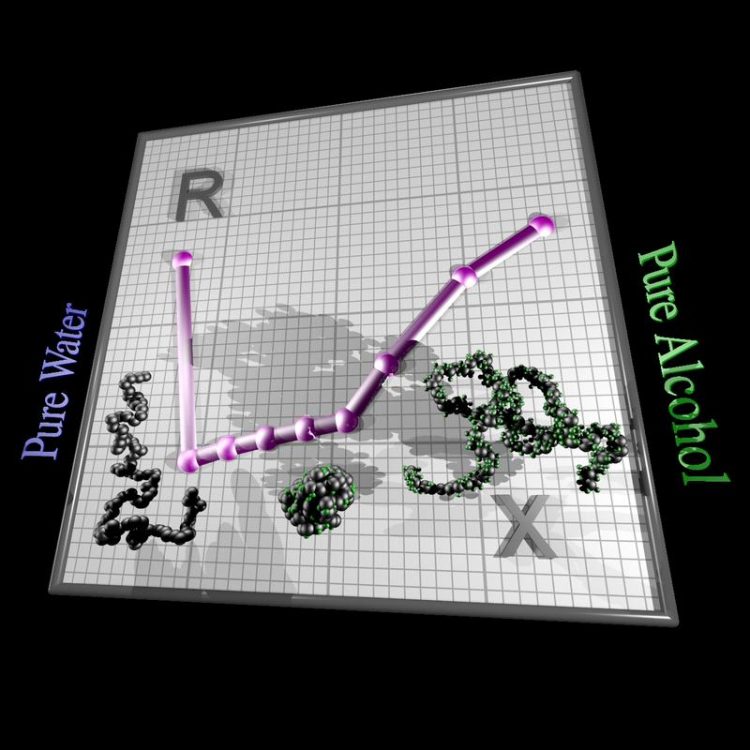Smart polymers: Complex matter where simplicity matters

Stimuli responsive polymers show an interesting coil-globule-coil transition in mixed solvents © Nature Communications
MPI-P scientists Kurt Kremer and Debashish Mukherji, together with their collaborator Carlos Marques from the French Centre national de la recherche scientifique (CNRS), propose a novel framework to understand the solubility of smart polymers in solvent mixtures. Combining “generic” molecular simulations with analytical theory, they solve a long standing question to explain the microscopic mechanism behind smart polymer collapse in mixtures of good solvents. Their results and findings are published in the most recent issue of the scientific journal “Nature Communications”.
Smart polymers are a modern class of polymeric material: they can be both artificial and produced by chemists or natural, as is the case for peptides. They exhibit a wide range of exotic and unpredictable behaviors when dissolved in mixed solutions. For example, while water and alcohol are well miscible and, individually, good solvents for several smart polymers, the latter precipitate in water-alcohol mixtures.
The intriguing behavior of solvent mixtures that cannot dissolve a given polymer, when the same macromolecule dissolves well in each of the cosolvents, is termed as co-non-solvency. Thus far the understanding of this effect is a matter of intense debate and, as such, it has eluded any generic explanation. Combining molecular dynamics simulations and analytical theory, they show that the co-non-solvency effect is a generic (independent of chemical details) phenomenon.
Their findings suggest that when a polymer is dissolved in a mixture of solvents, such that one of the (co)solvents likes the polymer even more than the other, this co-non-solvency effect can be observed. Therefore, a broad range of polymers are expected to present similar reentrant behavior.
One of the most intriguing findings of this work is that a polymer collapses even when the solvent quality becomes better-and-better by the addition of the better cosolvent, making the polymer conformation independent of the solvent quality. “This decoupling of solvent quality and polymer conformation is unexpected and new, opening interesting views for instance on the solution processing of polymers or biomedical applications such as pharmaceutical encapsulation” explains Kurt Kremer, director at the Max Planck Institute for Polymer Research.
These results not only provide the microscopic understanding of the co-non-solvency effect, but they also open new perspectives towards an operational understanding of macromolecular solubility within a simplified computational and/or theoretical framework.
http://www.mpip-mainz.mpg.de/4047686/Smart-polymers – press release and original publication
http://www.mpip-mainz.mpg.de/polymer_theory – information about Prof. Kremer's research
http://www.mpip-mainz.mpg.de/home/en – Max Planck Institute for Polymer Research
Media Contact
All latest news from the category: Physics and Astronomy
This area deals with the fundamental laws and building blocks of nature and how they interact, the properties and the behavior of matter, and research into space and time and their structures.
innovations-report provides in-depth reports and articles on subjects such as astrophysics, laser technologies, nuclear, quantum, particle and solid-state physics, nanotechnologies, planetary research and findings (Mars, Venus) and developments related to the Hubble Telescope.
Newest articles

Redefining Cancer Science: Rodents, Humans, and the PD-1 Puzzle
Results of a comprehensive analysis refute assumptions that a key immune checkpoint receptor functions the same in rodents and humans The Discovery of PD-1: A Milestone in Cancer Treatment Since…

Heart Surgery Risks: Low BP Linked to Postoperative Kidney Injury
First large cohort study at the Heart and Diabetes Center NRW awarded – Hilke Jung presents research project at the FoRUM conference of the Ruhr University Bochum A working group…

Microbial Secrets: Boost Plant Growth with the Power of Soil Bacteria
To stay healthy, plants balance the energy they put into growing with the amount they use to defend against harmful bacteria. The mechanisms behind this equilibrium have largely remained mysterious….



